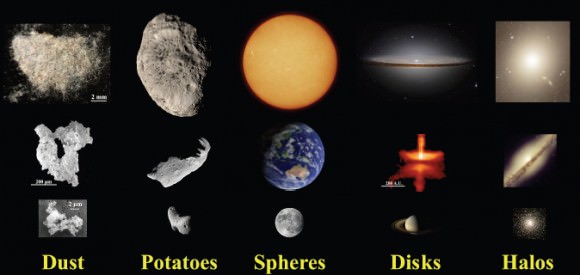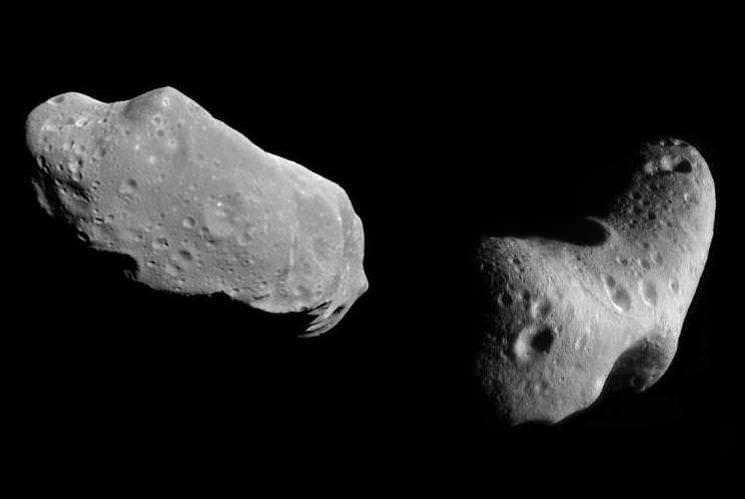Sometimes it’s good to take a break from mind-stretching cosmology models, quantum entanglements or events at 10-23 seconds after the big bang and get back to some astronomy basics. For example, the vexing issue of the potato radius.
At the recent 2010 Australian Space Science Conference, it was proposed by Lineweaver and Norman that all naturally occurring objects in the universe adopt one of five basic shapes depending on their size, mass and dynamics. Small and low mass objects can be considered Dust – being irregular shapes governed primarily by electromagnetic forces.
Next up are Potatoes, being objects where accretion by gravity begins to have some effect, though not as much as in the more massive Spheres – which, to quote the International Astronomical Union’s second law of planets, has sufficient mass for its self-gravity to overcome rigid body forces so that it assumes a hydrostatic equilibrium (nearly round) shape.
Objects of the scale of molecular dust clouds will collapse down into Disks where the sheer volume of accreting material means that much of it can only rotate in a holding pattern around and towards the centre of mass. Such objects may evolve into a star with orbiting planets (or not), but the initial disk structure seems to be a mandatory step in the formation of objects at this scale.
At the galactic scale you may still have disk structures, such as a spiral galaxy, but usually such large scale structures are too diffuse to form accretion disks and instead cluster in Halos – of which the central bulge of a spiral galaxy is one example. Other examples are globular clusters, elliptical galaxies and even galactic clusters.

The authors then investigated the potato radius, or Rpot, to identify the transition point from Potato to Sphere, which would also represent the transition point from small celestial object to dwarf planet. Two key issues emerged in their analysis.
Firstly, it is not necessary to assume a surface gravity of a magnitude necessary to generate hydrostatic equilibrium. For example, on Earth such rock crushing forces only act at 10 kilometres or more below the surface – or to look at it another way you can have a mountain on Earth the size of Everest (9 kilometres), but anything higher will begin to collapse back towards the planet’s roughly spheroid shape. So, there is an acceptable margin where a sphere can still be considered a sphere even if it does not demonstrate complete hydrostatic equilibrium across its entire structure.
Secondly, the differential strength of molecular bonds affects the yield strength of a particular material (i.e. its resistance to gravitational collapse).
On this basis, the authors conclude that Rpot for rocky objects is 300 kilometres. However, Rpot for icy objects is only 200 kilometres, due to their weaker yield strength, meaning they more easily conform to a spheroidal shape with less self-gravity.
Since Ceres is the only asteroid with a radius that is greater than Rpot for rocky objects we should not expect any more dwarf planets to be identified in the asteroid belt. But applying the 200 kilometre Rpot for icy bodies, means there may be a whole bunch of trans-Neptunian objects out there that are ready to take on the title.


Going up scale I would say there is another type of structure, voids and filaments
http://en.wikipedia.org/wiki/Large-scale_structure_of_the_universe
LC
Yes, agree. Perhaps they could have gone further with their schema. They did not touch on the apparent role of dark matter in shaping large scale structures (including galaxies).
Only solids can be potatoes!
I wonder what the minimal radii are for gaseous spheres; I guess it would depend, partly at least, on composition.
Liquids would always be spheres (I’m guessing that rotational ellipsoids count as spheres).
Planets other than icy or rocky? What would the Rpot be for iron objects? or carbon ones (formed in environments deficient in oxygen)?
The paper mostly discusses the limit on potato shaped objects. Transitions from spheres to disks involve rotational dynamics. A large cloud of gas with M >> 100M_sol and no angular momentum will gravitationally collapse and no thermal generating process can reverse this. If the cloud has some angular momentum collapse along the radial direction perpendicular to the z direction of the angular momentum is reduced. Collapse along the azimuthal direction parallel to angular momentum along a disk is reduced. For a unit of mass m the force along the z axis is approximately F = -Gdm, for d the mass per unit area of the disk, which does not have the divergent 1/r^2 term.
Of course there are nearly spherical shapes for dark matter halos around galaxies. These have virtually no dissipative processes, so the Louiville theorem applies and the volume of the distribution of particles remains constant.
Cheers LC
Yeah, filaments, voids, even streamers, waves et cetera. This is one of those classification schemes that captures some you want to capture but artificially leave stuff out that should go in.
[No, I don’t like them – except when they are helpful as here: Rpot is a spudific parameter!]
Now, now, I wouldn’t go that far, liquids can take such odd shapes when agitated in free fall. But only solids grow as potatoes (and vice versa).
Is that the one that states that the Derby winner has to have four legs? Or is that the Louisville theorem? [I keep forgetting. :-D]
Nitpicking: The _Liouville_ theorem applies, but I would note that the virial theorem is more “appropriate” here. That is “more classical” mechanics IIRC, and allowed to predict DM in the first place. Potato, potatoe.
“only solids grow as potatoes (and vice versa).”
So what about carrots? Strike “only” and I can stop this nitpicking of self. Errm, I can also let myself out through the door now.
Yep, I goofed the spelling — too early in the morning. At least I didn’t write Slugger with it.
Einstein at first objected to the idea that a body could collapse into Oppenheimer’s black hole, called a collapsar then, invoking Liouville’s theorem. Virial theorem, the magnitude of the average kinetic energy of particles in an n-body system (n >> 1) equals half the gravitational potential, does have some relevance as well. This holds for non-dissipative systems.
LC
It doesn’t affect the science in their paper, but they do have a misunderstanding about the IAU:
The IAU subsequently decided that unnamed trans-Neptunian objects (TNOs) with an absolute magnitude less than +1, which translates into a minimum radius of 419 km (Bruton 2008) would be defined as “dwarf planets”
The IAU didn’t redefine dwarf planets with the H < +1 criterion: it's merely a rule of thumb for naming purposes. The point is that it may be a very long time before we know whether any given object is hydrostatically shaped, and they don't want to wait to find out before assigning names. They therefore defined this brightness-based rule for naming.
However, if something with absolute magnitude of, say, 2, is subsequently found to be hydrostatically round, it's still a dwarf planet by IAU definition. It just ends up with a creation or underworld type of name, like Orcus, rather than one from wider mythology, like Eris or Haumea.